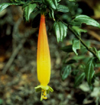SEARCH the
Gentian Research Network
and Rutgers University:
GENTIANS
Classification (newest)
List of genera
List by tribe
Gentian characteristics
Gentianales
RESEARCH
Research projects
People, addresses
Literature, publications
Links
Add info to
this site
TOPICS
Anatomy
Common names
Ecology - Natural history
GEOGRAPHY
Floras
Latin America
North America
TRIBES
Saccifolieae
_____________________
Information in other languages:
_____________________
This page
is maintained
by Dr.
Lena
Struwe
(e-mail),
and hosted by
Rutgers University, USA
updated: 01/19/11
|
Lagenanthus (Gentianaceae: Helieae) |
 |
||
|
Latin name and synonyms: Lagenanthus Gilg (1895) Etymology: Lagenanthus got its name from the Latin/Greek lagona/lagyna meaning a bottle, and anthos for flower, indicating the long, bottleshaped flowers of this genus. The species epithet princeps means leader/ruler in Latin. Species: Only one species, Lagenanthus princeps. Distribution: High elevation areas in mountains along the Colombian-Venezuelan border in South America. Habitat: Cloud forests. Characteristics: Branched shrub. Leaves ovate to ovate-lanceolate. Flowers solitary or few, terminal, hanging. Calyx campanulate, lobes ovate. Corollas long-tubular, slightly inflated, base yellow, middle with broad scarlet-red and orange bands; lobes short, rounded, green. Stamens inserted close to base of corolla tube; filaments long. Fruits capsules, thick-walled. Evolution and related plants: Lagenanthus belongs to the tribe Helieae but its closest relative within the tribe is not yet known. It shows some similarities to Lehmanniella and Purdieanthus. Economic uses: None known. Notes: Lindley
(1849) though this was
“one of the noblest plants in existence”,
and it has been nicknamed 'the king of the genus Lisianthius" and
cause a small sensation due to its beauty when it was discovered and
introduced to the European horticulture in the 1800s. It is no longer
cultivated. The species Lagenanthus parviflorus (Ewan, 1952) turned
out to be a species of another family (Rubiaceae) and synonymous with
Ravnia triflora (Maas, 1981). Accepted species (synonyms in parenthesis) and their distribution:
Ewan, J. 1952. A review of the neotropical lisianthoid genus Lagenanthus (Gentianaceae). Mutisia 4: 1-5. Maas, P. J. M. 1981. On the true identity of Lagenanthus parviflorus Ewan (Gentianaceae). Ann. Missouri Bot. Gard. 68: 685-688. Maas, P. J. M. 1985. Nomenclatural notes on neotropical Lisyantheae (Gentianaceae). Proc. Kon. Ned. Akad. Wetensch., Ser. C, 88: 405-412. Struwe, L., J. W. Kadereit, J. Klackenberg, S. Nilsson, M. Thiv, K. B. von Hagen, & V. A. Albert. 2002. Systematics, character evolution, and biogeography of Gentianaceae, including a new tribal and subtribal classification. Pp. 21-309. In: L. Struwe & V. A. Albert (eds.), Gentianaceae: Systematics and Natural History, Cambridge University Press, Cambridge
© Lena Struwe, 2004 |
|||
